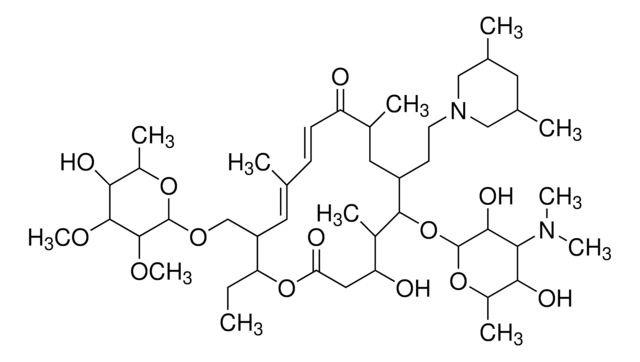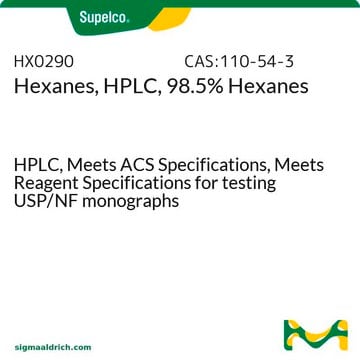34859
Hexane
≥97.0% (GC), suitable for HPLC, suitable for EPA 1613, EPA ACB B21-02, EPA OTM-45, and EPA ACB B23-05b
Synonyme(s) :
n-Hexane
About This Item
Produits recommandés
product name
Hexane, suitable for HPLC, ≥97.0% (GC)
Agence
suitable for EPA 1613
suitable for EPA ACB B21-02
suitable for EPA ACB B23-05b
suitable for EPA OTM-45
Densité de vapeur
~3 (vs air)
Pression de vapeur
256 mmHg ( 37.7 °C)
5.2 psi ( 37.7 °C)
~132 mmHg ( 20 °C)
Pureté
≥97.0% (GC)
Forme
liquid
Température d'inflammation spontanée
453 °F
Limite d'explosivité
7.7 %
Technique(s)
HPLC: suitable
Impuretés
≤0.0005% non-volatile matter
≤0.001% free acid (as CH3COOH)
≤0.01% water (Karl Fischer)
Résidus d'évap.
≤0.0005%
Transmittance
200 nm, ≥20%
225 nm, ≥80%
250 nm, ≥98%
Indice de réfraction
n20/D 1.375 (lit.)
pH
7
Point d'ébullition
69 °C (lit.)
Pf
−95 °C (lit.)
Densité
0.659 g/mL at 25 °C (lit.)
λ
H2O reference
Absorption UV
λ: 200 nm Amax: ≤0.70
λ: 225 nm Amax: ≤0.10
λ: 250 nm Amax: ≤0.01
Application(s)
food and beverages
Chaîne SMILES
CCCCCC
InChI
1S/C6H14/c1-3-5-6-4-2/h3-6H2,1-2H3
Clé InChI
VLKZOEOYAKHREP-UHFFFAOYSA-N
Vous recherchez des produits similaires ? Visite Guide de comparaison des produits
Catégories apparentées
Application
- Comparative Study of Gas and Liquid Chromatography Methods for the Determination of Underivatised Neutral and Acidic Cannabinoids and Cholesterol.: This research highlights the essential role of hexane in gas and liquid chromatography for analyzing complex mixtures in pharmaceuticals and clinical diagnostics, demonstrating its critical application in high-precision analytical methods (Czauderna et al., 2024).
- In Vitro Antioxidant and In Silico Evaluation of the Anti-β-Lactamase Potential of the Extracts of Cylindrospermum alatosporum NR125682 and Loriellopsis cavenicola NR117881.: This study employs hexane to extract bioactive compounds with potential antioxidant and antibacterial activities, showcasing its importance in novel drug discovery and antimicrobial resistance research (Ikhane et al., 2024).
- Exploration of reducing and stabilizing phytoconstituents in Arisaema dracontium extract for the effective synthesis of Silver nanoparticles and evaluation of their antibacterial and toxicological properties.: Demonstrates the use of hexane in the synthesis of nanoparticles, indicating its utility in nanotechnology and its impact on enhancing antibacterial properties of phytoconstituents (Khattak et al., 2024).
- Production and Physicochemical Characterization of the Gel Obtained in the Fermentation Process of Blue Corn Flour (Zea mays L.) with Colletotrichum gloeosporioides.: Focuses on the physicochemical properties of gels influenced by hexane extraction, pertinent to food science and material engineering (Villarreal-Rodríguez et al., 2024).
- Cloning, Expression, Characterization and Immobilization of a Recombinant Carboxylesterase from the Halophilic Archaeon, Halobacterium salinarum NCR-1.: This study involves hexane in the process of enzyme immobilization, highlighting its role in enhancing enzyme stability and activity, crucial for biotechnological applications (Ortega-de la Rosa et al., 2024).
Autres remarques
- The article number 34859-4X2.5L will be discontinued. Please order the single bottle 34859-2.5L which is physically identical with the same exact specifications.
- The article number 34859-6X1L will be discontinued. Please order the single bottle 34859-1L which is physically identical with the same exact specifications.
Mention d'avertissement
Danger
Mentions de danger
Conseils de prudence
Classification des risques
Aquatic Chronic 2 - Asp. Tox. 1 - Flam. Liq. 2 - Repr. 2 - Skin Irrit. 2 - STOT RE 2 Inhalation - STOT SE 3
Organes cibles
Central nervous system, Nervous system
Code de la classe de stockage
3 - Flammable liquids
Classe de danger pour l'eau (WGK)
WGK 3
Point d'éclair (°F)
-7.6 °F - closed cup
Point d'éclair (°C)
-22 °C - closed cup
Certificats d'analyse (COA)
Recherchez un Certificats d'analyse (COA) en saisissant le numéro de lot du produit. Les numéros de lot figurent sur l'étiquette du produit après les mots "Lot" ou "Batch".
Déjà en possession de ce produit ?
Retrouvez la documentation relative aux produits que vous avez récemment achetés dans la Bibliothèque de documents.
Les clients ont également consulté
Notre équipe de scientifiques dispose d'une expérience dans tous les secteurs de la recherche, notamment en sciences de la vie, science des matériaux, synthèse chimique, chromatographie, analyse et dans de nombreux autres domaines..
Contacter notre Service technique










